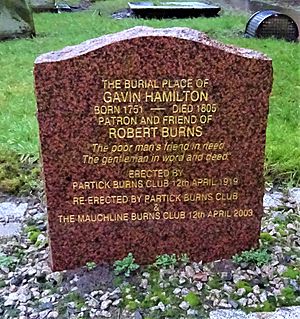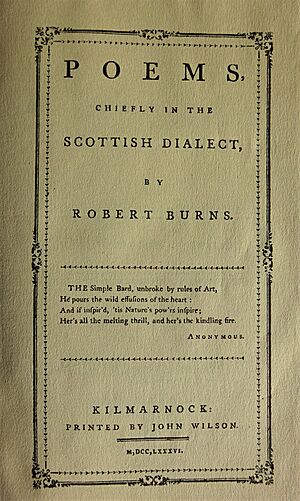Gavin Hamilton (lawyer) facts for kids
Quick facts for kids
Gavin Hamilton
|
|
|---|---|

Gavin Hamilton's memorial stone
|
|
| Born | 20 November 1751 Mauchline, Scotland
|
| Died | 1805. Mauchline, Scotland
|
| Occupation | Lawyer and Factor to the Earl of Loudoun |
Gavin Hamilton was a very close friend and supporter of the famous Scottish poet Robert Burns. The very first collection of Burns's poems, known as the 'Kilmarnock Edition', was even dedicated to Gavin Hamilton.
Contents
Gavin Hamilton: Robert Burns's Friend
Early Life and Family
Gavin Hamilton was born in 1751 in a town called Mauchline, Scotland. His father, John Hamilton, was a lawyer in Mauchline. Gavin followed in his father's footsteps and became a lawyer too. He also worked as a clerk for the Earl of Loudoun, managing some of his affairs.
Gavin bought an old building called the Abbot's Tower or Castle of Mauchline. He built a modern house next to it. Later, he sold this property to the Earl of Loudoun but continued to live there by leasing it back. In 1775, Gavin was put in charge of collecting money for poor relief in his area.
Gavin Hamilton married Helen Kennedy on July 10, 1775. They had eight children and raised their family in the house next to the old Abbot's Tower. Robert Burns mentioned two of Gavin's children, John and Jacobina, who was also called "little Beennie."
Gavin was known for being lively, generous, kind, and open. These qualities made him a very good friend to Robert Burns. He was also part of a religious group called the 'New Licht', which had more modern views compared to some older church groups.
In 1919, a memorial was put up for Gavin Hamilton at the church in Mauchline by a group called the Partick Burns Club. It was later fixed up again in 2003.
How Gavin Helped Robert Burns
Robert Burns probably first met Gavin Hamilton around 1783. Gavin was a big help to Burns, especially with his writing career.
Burns dedicated his first book of poems, the Kilmarnock Edition, to Gavin. Gavin was a great supporter, buying 40 copies of the book himself and helping to spread the word about it. When some people said that rich people weren't supporting Burns, Gavin spoke up and said that many gentlemen from Ayrshire had bought his poems.
The Mossgiel Farm Connection
In 1784, Gavin Hamilton leased a large farm called Mossgiel Farm. He had planned to use it as a summer home, but his wife didn't like the idea. So, in November 1783, Gavin rented the farm to Robert Burns and his brother Gilbert for £90 a year.
This was a helpful arrangement for the Burns family. Their father was having legal problems with his farm lease and was very ill. Mossgiel Farm had been built by Gavin Hamilton just a few years before, so it was a comfortable place to live. This arrangement helped protect the Burns family's money.
Between 1785 and 1786, Gavin Hamilton employed a young woman named Mary Campbell as a nursery maid. She is better known as 'Highland Mary'. It's likely that Burns first met her at Gavin's home.
Gavin also helped Burns with legal documents. For example, he wrote down the birth date of Burns's daughter, Elizabeth Bishop, who was also known as Dear-bought Bess.
Gavin encouraged Burns when he thought about moving to Jamaica. He was friends with Captain Smith, who was the master of the ship Burns planned to take. But after the Kilmarnock Edition became a success, Gavin advised Burns to stay in Scotland and suggested he could work in the excise (collecting taxes).
In 1786, Gavin delivered a letter to Burns from Dr. Blacklock. This letter praised Burns's poems and encouraged him to stay in Scotland, which he did. Gavin Hamilton and Robert Burns were both Freemasons. They even went to a lodge meeting together in March 1786.
Letters Between Friends
Burns and Gavin Hamilton wrote many letters to each other. In one letter, Burns talked about Gavin's half-sisters and brothers who lived near Dollar. Burns visited them and wrote to Gavin about his visit, especially mentioning Charlotte Hamilton, whom he called the "Maid of Devon." He also mentioned Gavin's son, John, saying he was "so good a boy and so fine a scholar."
When Burns first arrived in Edinburgh in 1786, he shared a room with another friend from Mauchline, John Richmond. John had once worked for Gavin Hamilton.
Burns wrote openly to Gavin about Jean Armour, saying he missed her very much. In another letter from Edinburgh in December 1786, Burns joked about how famous he was becoming.
In February 1788, Burns wrote to Agnes Maclehose that he was on his way to visit Gavin Hamilton. He said that meeting old, dear friends made him almost forget his other concerns for a moment.
Poems for Gavin
Robert Burns wrote several poems that mentioned or were dedicated to Gavin Hamilton:
- "Epitaph for Gavin Hamilton Esq" (1786):
|
"The poor man weeps here Gavin sleeps |
- "A Dedication to Gavin Hamilton Esq." (1786): This poem was a special dedication to Gavin. The first part says:
|
"Expect na, sir, in this narration, |
- "To Mr Gavin Hamilton Esq., Mauchline. Recommending a boy, Mossgaville, May 3, 1786": In this poem, Burns asked Gavin to consider hiring a boy who had worked for him. He joked about the boy possibly working for a cattle dealer with a bad reputation. The first part of the poem goes:
|
"I hold it, sir, my bounden duty |
- "To the Rev. John McMath": This poem described Gavin Hamilton:
|
"There's Gaw'n, misca'd waur than a beast, |
- "Nature's Law. Humbly Inscribed to Gavin Hamilton, Esq.": This poem was also dedicated to Gavin. The first part says:
|
Let other heroes boast their scars, |
A Challenge and a Poem
One Sunday, Burns visited Gavin Hamilton, who couldn't go to church because of gout. Gavin challenged Burns to write a poem about the sermon they would hear. The minister's topic was "And ye shall go forth, as calves of the stall." Burns won the challenge, and his poem became part of "The Calf."
Two of the original parts from "The Calf":
|
"Tho' when some kind connubial dear And, in your lug, most reverend James, |
This poem was first published in 1787. It caused the minister, Rev. James Steven, to be nicknamed "The Calf."
Gavin Hamilton and Robert and Jean's Marriage
It is said that Robert Burns first met Jean Armour when his dog ran over some clothes on a drying green in Mauchline. Jean scolded the dog, and that's how they met.
When Jean Armour and Robert Burns got married in a less formal way that was still legal, Jean's father was not happy. He tried to get the marriage canceled. He didn't go to a lawyer in Mauchline because Gavin Hamilton was a friend of Burns.
On May 2, 1788, Robert and Jean were officially married in a legal but informal ceremony. This likely happened in Gavin Hamilton's house, performed by a Justice of the Peace. Burns was quite private about this marriage. Gavin's eldest daughter, Jacobina, remembered finding out about it at breakfast one day when Burns joked that if she wanted a boiled egg, she could send to "Mrs. Burns."
Problems with the Church Minister
Gavin Hamilton had some disagreements with the local church minister, Rev. William 'Daddy' Auld. Gavin was in charge of collecting money for the poor, and there were problems with how the money was handled.
The minister also made a formal complaint against Gavin because he had asked a servant to dig potatoes on a Sunday during church time. The servant was publicly scolded by the church. However, the servant showed his loyalty to Gavin by naming his son Gavin Hamilton Bryan, which was unusual at the time.
Gavin was found guilty by the church of breaking some religious rules. He appealed this decision, getting his friend, lawyer Robert Aiken, to help him.
Robert Burns strongly supported Gavin during this time. Burns wrote poems that criticized the 'Auld Licht' (old light) church group, including "Holy Willie's Prayer" and "The Holy Tulzie."
Images for kids
See also
- Robert Aiken
- Jean Armour
- Lesley Baillie
- John Ballantine
- Alison Begbie
- Nelly Blair
- Isabella Burns
- May Cameron
- Mary Campbell (Highland Mary)
- Jenny Clow
- Helen Hyslop
- Nelly Kilpatrick
- Jessie Lewars
- John McMurdo
- Anne Rankine
- John Richmond (lawyer)
- James Smith (draper)
- Isabella Steven
- Peggy Thompson







